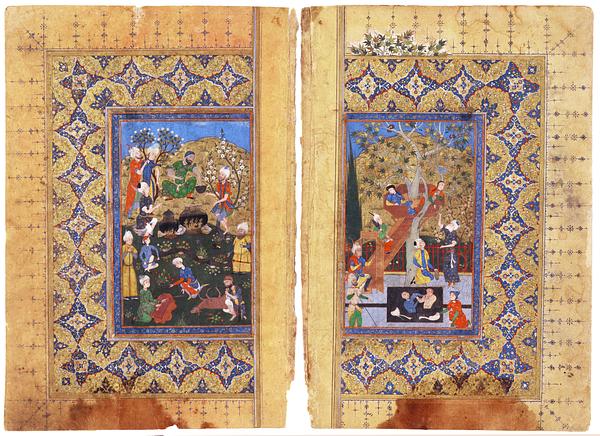Double frontispiece painting from a copy of Jami’s Yusuf wa Zulaykha. ‘Picnic in a Tree House’
Iran, Qasvin; 1550-1570
Each leaf: 28.5 × 19 cm
As is so often the case in Persian manuscripts, this frontispiece has nothing to do with the main text. The subject of the painting is a preparation for a small gathering, where the protagonists are the two young men relaxing in a tree house erected in a plane tree.
What makes the painting so interesting is what happened after the manuscript was completed.
A later owner had religious scruples about owning a manuscript filled with figurative paintings. A closer look shows that he meticulously and with some care painted a thin red line across the necks of all the living persons (including the slaughtered animal). He symbolically killed them all. No one – neither God nor man – would be able to accuse him of owning images of living beings.
There is no actual prohibition against images in the Koran, but the hadith, traditions of the words and life of the Prophet Muhammad, note that those who make or own paintings would fare badly on the Day of Judgment
Inv. no. 51/1980 & 52/1980
Published in:
Islamic art from the Collection of Edwin Binney 3rd, circulated by the Smithsonian Institution Traveling Exhibition Service, 1966-1968, Washington 1966, cat.no. 37 (only 52/1980 illustrated);
[B. W. Robinson et al.]: Persian and Mughal art, Colnaghi, London [1976], cat.no. 20;
Art from the World of Islam. 8th-18th century, Louisiana, Humlebæk 1987, cat.no. 226;
Kjeld von Folsach: Islamic art. The David Collection, Copenhagen 1990, cat.no. 28;
Kjeld von Folsach, Torben Lundbæk and Peder Mortensen (eds.): Sultan, Shah and Great Mughal: the history and culture of the Islamic world, The National Museum, Copenhagen 1996, cat.no. 45;
Kjeld von Folsach: Art from the World of Islam in The David Collection, Copenhagen 2001, p. 49, fig. 11 (only 51/1980);
Barbara Brend : “The pillar and the pictures: an interpretation of the 'Diwan-i Khass' at Fathpur Sikri”, in Warwick Ball and Leonard Harrow (eds.): Cairo to Kabul: Afghan and Islamic studies, London 2002, p. 53 (only 52/1980);
Sheila S. Blair and Jonathan M. Bloom (eds.): Cosmophilia. Islamic Art from the David Collection, Copenhagen, McMullen Museum of Art, Boston College, Boston 2006, cat.no. 16;
Catharina Raudvere: ”Billedforbud i islam” in Lisbeth Christoffersen (ed.): Gudebilleder : ytringsfrihed og religion i en globaliseret verden : antologi, København 2006, pp. 34-35;
Kjeld von Folsach: For the Privileged Few: Islamic Miniature Painting from The David Collection, Louisiana, Humlebæk 2007, cat.no. 48;
Tanya Treptow and Donald Whitcomb: Daily life ornamented: the medieval Persian city of Rayy, Oriental Institute Museum of the University of Chicago, Chicago 2007, p. 25 (only 51/1980);
Joseph Allen Boone: The homoerotics of Orientalism, New York 2014, p. 311, fig. 73;
Kjeld von Folsach, Joachim Meyer: The Human Figure in Islamic Art – Holy Men, Princes, and Commoners, The David Collection, Copenhagen 2017, fig. 18, p. 56 (only 51/1980);
Axel Langer (ed.): In the name of the image : Figurative representation in Islamic and Christian cultures, Museum Rietberg, Zürich, Berlin 2022, cat. 40, pp. 96-97, 99;
Ivan Z. Sørensen: Albondocani: Blixen og islam. Med Karen Blixens Kongesønnerne, København 2022, fig, 6, p. 21 (only 52/1980);
